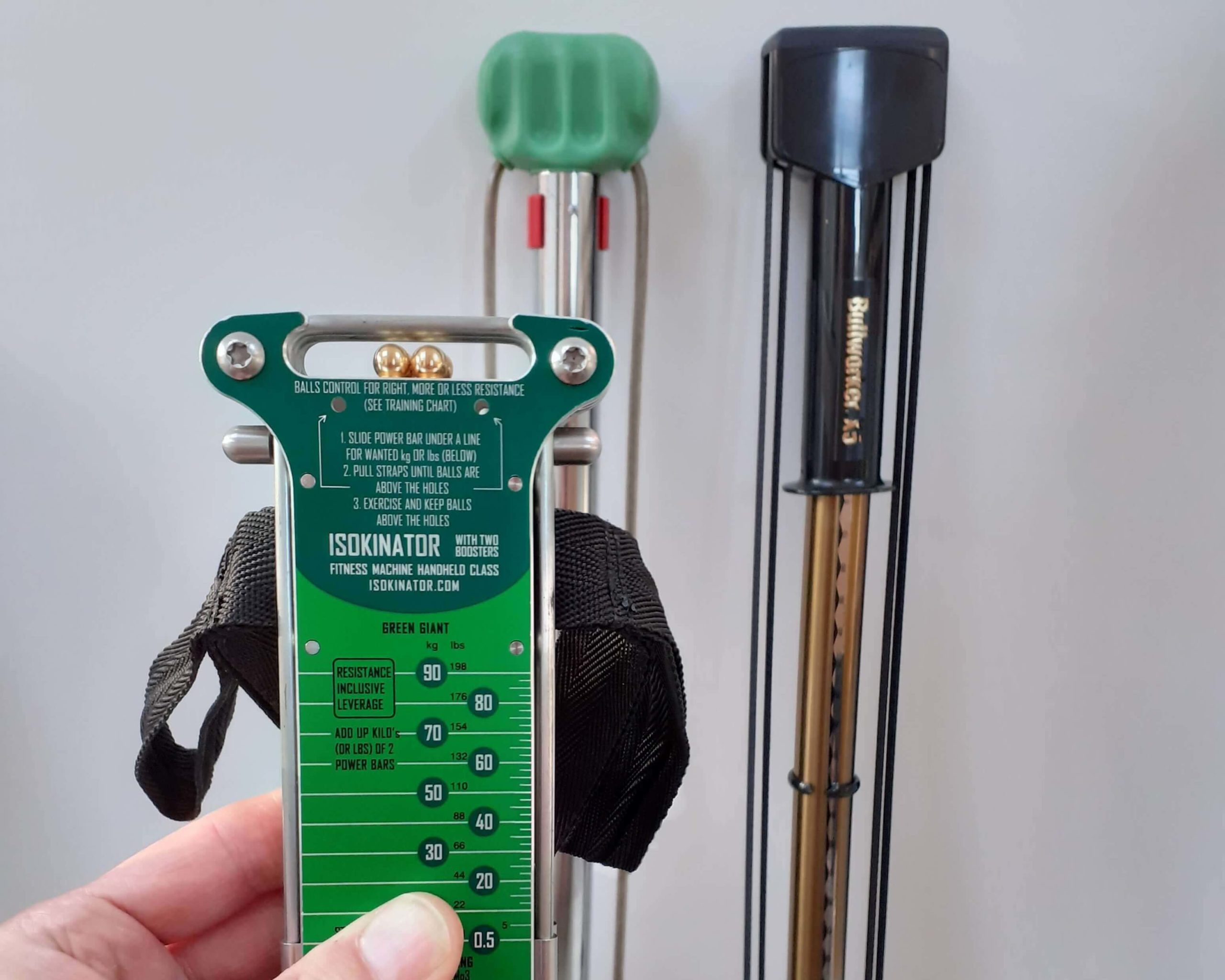I’ve had my Bullworker X5 since the 1980s. It’s a simple design: it consists of a cylinder that contains a powerful spring; with two handles at each end which are held together with double banded nylon straps. Pulling the straps apart forces the handles together and compresses the spring. Alternatively, the handles can be squeezed together to obtain a similar result.
Surrounding the cylinder is a plastic ring which is used as a ‘power meter’ to measure your strength progress. It is moved down the cylinder by the handle as it is compressed. The cylinder has a marked scale so you can read off the number to monitor how you’re doing on any particular movement.

There are literally dozens of exercises that can be performed with the Bullworker, each targeting specific body parts such as the chest, back, arms, shoulders and legs.
The History of the Original Bullworker
The Bullworker was invented by Gert F. Kolbel in the early 1960s and since then over 9 million units have been sold.
It’s been a popular workout tool in America, Asia and Europe.
The original design was called a Tensolator and went through various design changes, one of which was the highly popular Bullworker X5.
The modern Bullworker (link to Amazon) has evolved into a very ergonomically designed unit that is very comfortable to use.
The Bullworker X5 can be used both isotonically – involving movement – or isometrically – with static contractions.
Using the Bullworker for Isotonic Contractions
Regular weight training involves Isotonic contractions. The weights are raised and lowered in a rhythmic movement. Typically each muscle moves from a fully extended position back and forth to a fully contracted position. Each up and down movement is called a ‘rep’ (repetition). A series of consecutive reps are called a ‘set’
You can workout in a similar way using the Bullworker by pushing the handles together in a series of ‘pulses’ or reps.
The spring actually gets harder to move the further it is compressed. This mirrors the way the muscles of the body operate: the more they are contracted the more force they are capable of exerting.
You can prove this yourself by performing a barbell curl with your arm fully extended. The amount of weight that you can move will be much lower compared to when your arms are bent at right angles.
The movement of the Bullworker becomes harder as the muscle contract and are able to generate more force. This makes a very effective workout for the muscles that are targeted.
At a certain point, compressing the spring any further will become impossible and the muscles can be allowed to relax enabling the Bullworker to return to its original position.
Avoid any time for the muscles to recover fully, the Bullworker is again compressed. This pattern is repeated until either the desired number of repetitions is reached or the muscles are simply too tired to continue.
Using the Bullworker for Isometric Contractions
Isometric exercises involve the muscles contracting but they do not change length and consequently there is no resultant movement.
Imagine pushing against a solid concrete wall with all your might. Your muscles will tense and will be working extremely hard but the wall won’t move (unless you’ve employed a very shoddy builder!).
Isometric training is a highly effective form of training for the following reasons:
- It’s quick. Each contraction typically lasts from 7 to 15 seconds. This constitutes one set.
- It’s safer on the joints. There is no movement so very little wear on the joints
- It’s highly effective. Research by NASA found that it was as effective as muscle contraction and muscle lengthening training ie normal weight lifting
- It’s easy to target the desired muscle. With isometrics you can feel the tension in the muscle being affected. This allows you to build the mind-muscle connection and really train the area you’re targeting.
With the Bullworker, you can compress the handles as hard as you can and hold them statically in place for 7 – 15 seconds. Alternatively, the straps can be pulled apart and held in place for the desired amount of time.
The Bullworker can be used for dozens of exercises some of which can be seen in the video below:
The Bullworker X5 is a very well built piece of kit. I’ve used mine regularly since the 1980s and it’s still functioning perfectly.
The design has improved since the Bullworker X5 originally came onto the market. It now features ergonomic handles and, in addition, it comes with a selection of springs. Changing the springs allows for a greater compression enabling a more complete isotonic contraction.
It also allows you to easily progress your level of strength. Once you can fully contract the Bullworker using the weakest spring, you can move on to the next level of spring.
The last time I looked, the modern Bullworker retailed for about $150 but you can see the latest price on Amazon here.
You can see my thoughts on other isometric training tools here.
Related Articles:
The Bullworker Iso-Bow Review
Isometrics build muscle fast!!
Isometrics for martial arts: how you can get really strong
Is the Bullworker as good as weights?
Bullworker vs Isokinator vs Isobow
The best isometric exercise equipment 2022(with pictures)
Will a Bullworker build muscle?
References:
https://en.wikipedia.org/wiki/Bullworker
https://www.nasa.gov/vision/earth/livingthings/10dec_muscles.html

